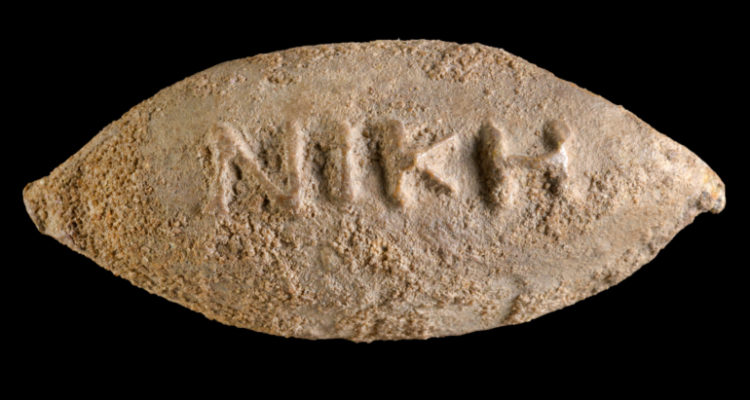‘Tangible evidence of a fierce battle.’ 2,200-year-old lead sling bullet bearing Greek inscription found in Yavne
By World Israel News Staff
New research has revealed a lead sling bullet from the Hellenistic period, rare of its kind in Israel, with an inscription in Greek intended to ensure victory in battle.
The 2,200-year-old sling bullet, which bears the inscription – “Victory of Heracles and Hauronas”, was uncovered in excavations conducted by the Israel Antiquities Authority in Yavne as part of the Israel Lands Authority’s initiative to expand the city, in cooperation with the Yavne Municipality.
The length of the sling bullet is 4.4 cm, and it was intended to be used in an early sling.
“The pair of gods Hauron and Heracles were considered the divine patrons of Yavne during the Hellenistic period,” says Prof. Yulia Ustinova from Ben Gurion University of the Negev, who deciphered the inscription.
“Actually, the inscription on a sling bullet is the first archaeological evidence of the two guardians of Yavne, discovered inside Yavne itself. Until today, the pair was only known from an inscription on the Greek island of Delos.”
As a couple, the gods Heracles and Hauron were a perfect team of victory givers.
“The announcement of the future victory of Heracles and Hauron was not a call addressed to the deity, but a threat directed towards the adversaries,” says Prof. Ustinova.
“Lead sling bullet are known in the ancient world beginning in the 5th century BCE, but in Israel few individual sling bullets were found with inscriptions. The inscriptions convey a message of unifying the warriors with the aim of raising their spirits, scaring the enemy, or a call intended to magically energize the sling bullet itself.”
“These inscriptions were part of psychological warfare, the main purpose of which is to terrorize the opponent, and in addition, to unite the warriors and raise their spirits.”
“It seems that we will not be able to know for sure if the sling bullet belonged to a Greek soldier,” say Pablo Betzer and Dr. Daniel Varga, the directors of the excavation on behalf of the Israel Antiquities Authority, “but it is not impossible that it is related to the conflict between the Greeks and the Hasmoneans.”
“In the 2nd century BCE, pagan Yavne – which was an ally of the Seleucids (the Greeks who ruled Eretz-Israel), were subject to attacks by the Hasmonean armies.”
“The Hasmoneans sought, to subjugate the other nations and create a homogeneous and ‘pure state’ from a religious-ritualistic point of view. The tiny lead sling bullets, announcing the imminent victory of the gods of pagan Yavne, is tangible evidence of a fierce battle that took place in Yavne at that time.
“One can only imagine what that warrior who held the sling bullet 2,200 years ago thought and felt, as he held on to the hope of divine salvation,” says Eli Escusido, Director of the Israel Antiquities Authority. The Yavne excavation is a ‘mega’ excavation – one of the largest conducted by the Israel Antiquities Authority.





